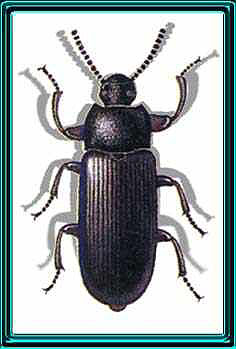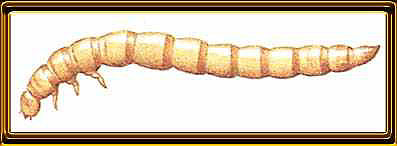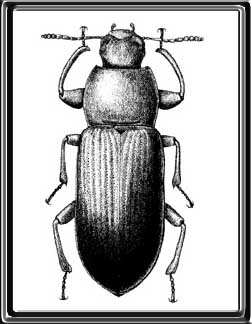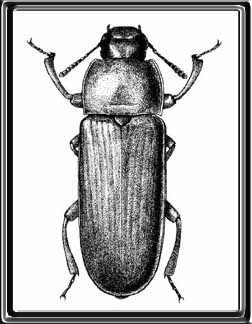
Tenebrio
molitor
(Yellow Mealworm Beetle)
(Yellow Mealworm Beetle)

Yellow Mealworm Beetles are considered scavengers and are among the largest insects that infest stored products. Most prefer to feed on decaying grain or milled cereals in damp, poor conditions. These insects are usually found in places not frequently disturbed such as dark corners, under sacks, in bins and where feed is stored. Indoors, they are usually found in basements or at grade level, sometimes infesting cornmeal, flour, cake mixes, cereals, meat scraps, dead insects, bran and litter from chicken houses, they have even been found in sparrow's nests where they feed on the droppings. Mealworms have been found living under old carpeting and in straw-stuffed chairs in damp areas. Yellow mealworm larvae are known as "golden grubs" (see above) and make excellent fish bait and serve as food for animals in aquariums and zoological parks.Identification:
Young larvae are white, darkening with age. Larvae of yellow mealworms are honey-yellow, while dark mealworms are dark-brown.
Mealworms have a smooth, highly polished, shiny, elongate, hard, cylindrical (wormlike) body about 1/8 inch thick and up to 1.25 inches long at maturity. Beetles are robust, black and nearly 3/4 inch long, resembling many ground beetles in size, shape and color.
Yellow mealworm adults are shiny, dark-brown or black, whereas dark mealworm adults are dull, pitchy black. Eggs are white, bean-shaped and about 1/20 inch long. Pupae are white at first, turning yellow, and are not enclosed in a case or cocoon.
Mealworm adults do not move as fast as ground beetles. Also, the hind leg of a mealworm adult has only four tarsal segments, while the hind leg of a ground beetle has five tarsal segments.
There is another species of mealworm known as the Dark Mealworm (Tenebrio obscurus). Young larvae are white, darkening with age. Larvae of yellow mealworms are honey-yellow, while dark mealworms are dark-brown. The difference between the adults is shown in the pictures below with the Dark Mealworm Beetle being on the left:


Pictures courtesy of Ohio State University
Life Cycle and Habits:
Tenebrio beetles are black or dark brown and they feed as larvae and adults on grain products. T. molitor is an important post-harvest pest and occurs spread all over the world. Adult beetles are attracted to night-lights, are strong fliers, and are found in dark places. Each female lays about 275-600 eggs, which hatch into larvae in 4 to 14 days. Eggs are laid singly or in clusters during the spring over a period of 22 to 137 days. Larvae firstly eat the germs of stored grains and can feed on a wide variety of plant products such as ground grains, flour, tobacco and foodstuffs. Larvae are very voracious and highly resistant to low temperature; they can remain alive for 80 days at -5°C. Larvae may spend up to two years in this stage depending on the environment. Individual larvae may wander far from the food source to pupate, making it difficult for homeowners to locate the source of infestation.
Most larvae mature by fall, overwinter and pupate in the spring, with the pupal stage lasting 7 to 24 days. Adults emerge in the spring and early summer, living two to three months.
On warm summer evenings they often fly in through the open windows attracted, as we've already said by the light. They normally do no harm in the living rooms of houses and as they take so long to develop they do not become a problem in domestic kitchens.
Prevention:
Mealworms are not always considered pests since some people raise them for fish and animal food.
Use good night-light discipline to reduce beetle attraction and infestation indoors (in the countries where this applies). Sanitation is the simplest means of controlling mealworms. Moist, dark, undisturbed areas containing damp grain or milled cereals should be eliminated. Litter remaining in old or abandoned poultry houses can create explosive infestations, bothering residents as far as 1/2 mile away. Poultry litter dumped into piles outdoors can result in mealworm migrations indoors. Waste grain products in a sanitary landfill may become a source of infestation.
Again the measures taken to prevent this pest in an industrial environment should be on-going anyway and if allowed to get to the point where they are a major problem, then fumigation would be the only alternative. But as I've said before.....Housekeeping, Housekeeping....etc.